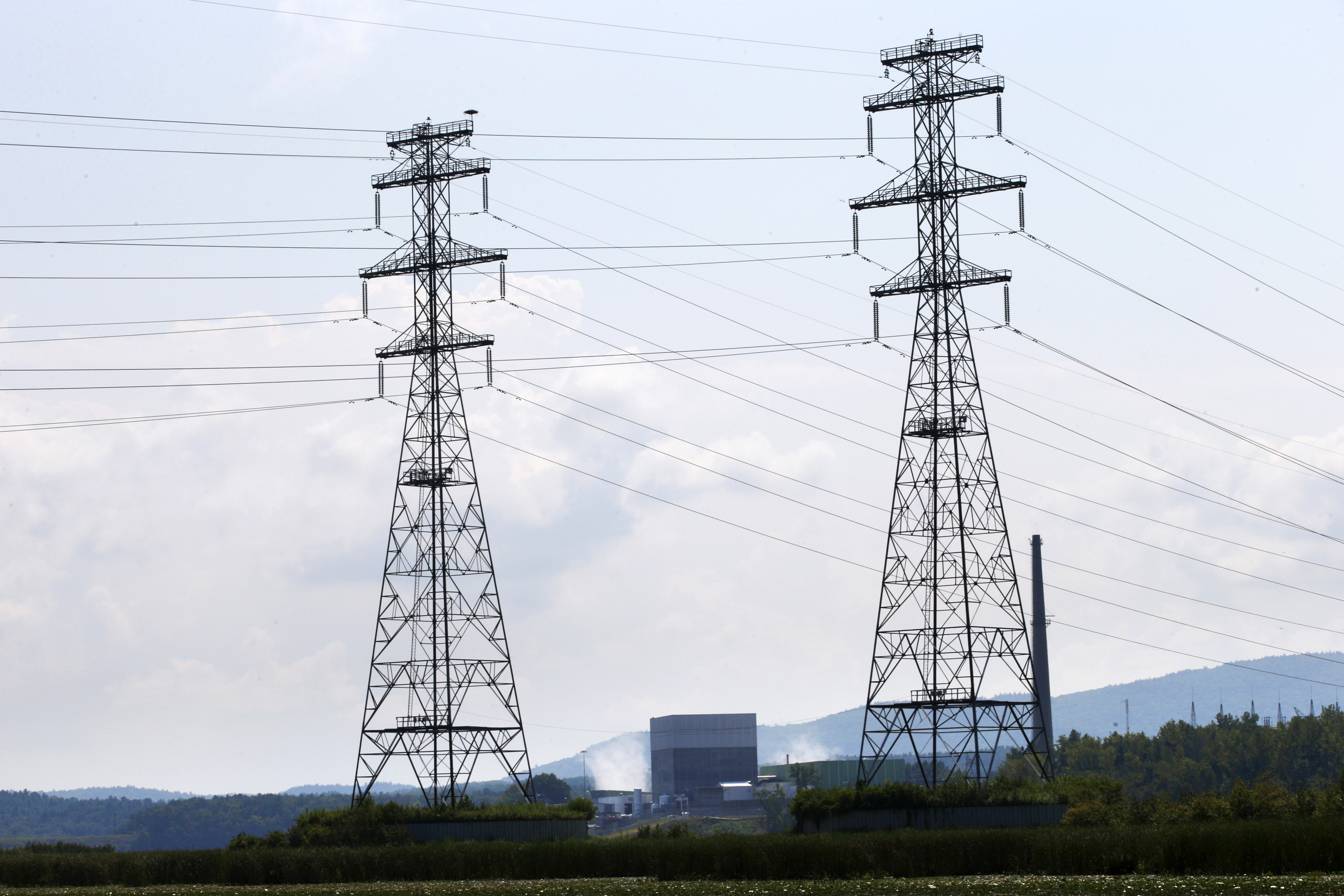In a recent private roundtable on global electricity and technology held by the
Energy Security and Climate Initiative
, participants discussed the benefits and challenges of implementing performance-based utility regulation. This summary reflects some of the key points in the discussion.
As discussed in a previous Brookings report, the U.S. electric utility industry is undergoing a dramatic transformation. Three major inter-related factors are converging to drive this change: policy, technology, and customer engagement.
- Federal, state, and local policies are supporting the increased deployment of renewable energy and distributed energy resources (DER) such as rooftop solar PV, storage, electric vehicles, demand management tools, and micro-grids;
- Costs for many of these technologies continue to decline; and
- Customers are demanding more control and information regarding their energy use.

Power lines in Hinsdale, New Hampshire, lead away from the Vermont Yankee nuclear power plant (C rear) in Vernon, Vermont August 27, 2013. (REUTERS/Brian Snyder)
Initially, most of the debate on the impact of these trends has focused on the “death spiral” for utilities and how the existing business model of traditional, large central-station, one-way power and information flows from utility to customer will increasingly become obsolete. Recently, however, the tone of this discussion has changed: More and more utility executives view DER and the customer relationship as the biggest growth opportunities in the coming years. Consequently, the focus is moving from hand-wringing to proactively figuring out the model for utilities to sell kWhs and services, including whether there is a role for utilities in the DER market.
Lisa Wood and I have previously discussed how utilities are answering this challenge by playing a key role in the evolving distribution grid, but important questions remain: Who owns and operates the grid, enabling these new resources to connect? How do we monetize and value the array of services and resources at the grid edge?
The need for performance-based regulation
This raises the critical issue of the regulatory framework. The current cost of service regulatory model emphasizes building infrastructure in order to keep the lights on (reliability) at an affordable cost. This regulatory approach has served society well over the last 100 years, but it does not accommodate the recovery of investment in services and meeting broader societal goals. As noted by a participant in our roundtable: “In the current regulatory system, all equity investment earns the same return despite disparity in value and risk.”
The U.S. electric utility industry is undergoing a dramatic transformation. Three major inter-related factors are converging to drive this change: policy, technology, and customer engagement.
Performance-based regulation (PBR) promotes a shift from cost of service to value of service and provides a way for utilities, customers, and broader society to meet their respective goals. Setting performance metrics beyond investment in assets connects shareholder value to the customer and rewards utilities for reaching agreed upon policy goals.
Performance-based regulation in action
New York, through its Reforming the Energy Vision regulatory procedure, is considering changing the existing regulatory framework and implementing a PBR model with two proposed mechanisms. The first, earnings impact mechanisms (EIMs), allow a utility to earn higher returns if it meets certain performance metrics, including peak load reductions, energy efficiency deployment, interconnection of DERs, customer engagement and information access, and affordability. In the second–market based earnings (MBEs)–a utility serves as a distribution systems platform (DSP) and can charge fees for services offered on this grid platform, such as providing dispatch and balancing services for DER on the grid or referring customers to service providers. As one participant stated, the MBE model envisions how “a utility could serve as a storefront for the customer.”
A key aspect of PBR models is that they are forward looking: The emphasis is on “how to pay for what society wants over a sufficiently long time horizon, rather than focusing on whether society paid the correct amount for what it got in the past.” Performance-based regulatory models with multi-year plans incentivize utilities to modernize their operations and align customer needs with company goals and policy goals. Multi-year plans look forward and can create opportunities for a system ready to make a transition to a more efficient, cleaner, and more distributed electricity system. For example, Minnesota uses a multi-year plan that according to the State Legislature can replace annual rates as long as it bases a portion of utility revenue on encouraging efficiency and rates are reasonably in line with the costs of service during the time period. This allows Minnesota utilities to accommodate a variety of changes while providing opportunities for more efficient and affordable service to customers.
Implementation challenges
Implementing a PBR framework faces several challenges. First, several contributors at the discussion noted that incentive regulation–rewarding performance, efficiency, and lowering costs–has been around for a long time, including in the United States, and the revenue cap (RPI-X) approach was implemented in the United Kingdom several decades ago but does not seem to have gained traction in this country. While there is no simple answer to explain this, it may be owing to the “complexity of diversity and over-judicialization” of the electricity sector in the United States.

Four reliability coordinators monitor the state power grid during a tour of the Electric Reliability Council of Texas (ERCOT) command center in Taylor, Texas August 14, 2012. (REUTERS/Julia Robinson)
From the utility perspective, it is important to note that while the industry may be changing in very dynamic ways, it also important to consider the ways in which it remains the same:
- Customers continue to demand reliable electricity service at a reasonable price;
- The grid itself is still critically important, especially to support the transformation taking place (as one participant noted, “the grid is still in the money”); and,
- There still needs to be a balance between centralized generation and distributed generation.
Any changes in the regulatory approach must not only account for these realities, but stakeholders must also recognize the impacts of moving toward a PBR framework on the financial health of utilities. As one expert noted: “If all profits come from PBR, risk increases and you get a different class of investors.” These factors argue for gradual implementation of any changes to the regulatory compact.
Participants raised other concerns with PBR. As electricity markets continue to evolve, stranded assets may grow and it is important to start thinking now about how to deal with or avoid this issue. With more and more renewables being added to the system and prices declining rapidly, policies will continue to evolve, potentially complicating a broader re-working of the regulatory approach. The debate over net metering is an example, where the discussion has moved from what to do with the policy itself to an appropriate rate design to recover the cost of using the grid (for example, use of fixed charges, demand charges, value of solar tariffs). There is also the two-part challenge of determining broader societal goals and the specific performance metrics to measure how they are being achieved. Different states will certainly have different goals and metrics, and there does not yet seem to be any emerging consensus.
From the utility perspective, it is important to note that while the industry may be changing in very dynamic ways, it is also important to consider the ways in which it remains the same.
This brings us to two final key observations from the roundtable. First, stakeholders and proponents of DER as well as the utilities agree that the regulatory model has to change. Second, communication and collaboration among governors, state legislatures, regulators, and utilities is key to bring performance-based regulation into common practice. In particular, policymakers in state governments need to lead in setting priorities and working with utilities and regulators in designing performance-based regulation that provides a way for utilities to be rewarded for meeting customer demands while still providing safe, reliable, and affordable service.
The Brookings Institution is committed to quality, independence, and impact.
We are supported by a diverse array of funders. In line with our values and policies, each Brookings publication represents the sole views of its author(s).



Commentary
Why performance-based regulation is important for the electric utility transformation
December 3, 2015